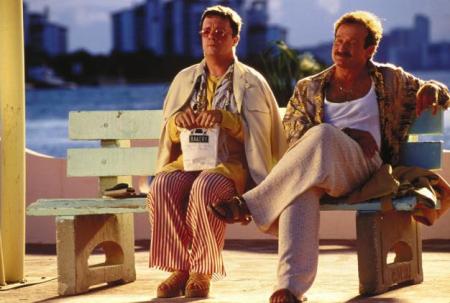Great Moments in Gayness: "Fosse, Fosse, Fosse"
 Monday, June 24, 2013 at 1:00PM
Monday, June 24, 2013 at 1:00PM Happy Gay Pride Week Everyone!
Dancin' Dan here to wish you all a Happy Gay Pride Month! When I think about the first gay person I ever saw on screen, I usually think of Rupert Everett in My Best Friend's Wedding, a performance I kind of love in a film that actually has a very gay sensibility. But just recently I realized that there was a much gayer mainstream Hollywood hit which came out the year before that Julia Roberts vehicle : The Birdcage.
Yes, in 1996, The Birdcage was a massive hit. It was also, oddly enough, a prestige comedy - based on a popular French play-turned hit crossover film, directed by Oscar winner Mike Nichols, starring Oscar nominee Robin Williams and Oscar winners Gene Hackman and Dianne Wiest (the cast, which also starred soon-to-be-Tony winner Nathan Lane, actually won the Best Ensemble SAG Award that year). It grossed over $100 million. And not only did a good percentage of the film take place in the titular drag club, its two main characters were gay. [more...]

I've seen a lot of shit slung in The Birdcage's direction over the years, but despite the silliness, the relationship between Armand and Albert is very strong and handled with great care. In fact, the film basically comes right out and says that the two of them should not be ashamed of who they are and shouldn't have to hide - it even all but flat-out states that they should get married.
But I'm not here to talk about how important the film is, or how funny, or how subversive. I'm here to talk about what the film is probably remembered for most today:
As a young boy into dance, I loved this moment. I could feel the sense of history running through it, and I laughed even at the names I didn't recognize. When I got older and learned more about the work of Martha Graham and Twyla Tharp, I realized just how dead on an impersonation Robin Williams give here. Actually, the first one, Fosse (aka the one everyone remembers), is probably the worst approximation of all of them. But the bits of Martha Graham, Twyla, and Michael Kidd are perfect spoofs - a distillation of their essence as choreographers packaged into one piece of movement.
It's actually the Twyla that makes me laugh the hardest. If you want to know why, just check out the beginning of In The Upper Room. The arms! It's all about the arms with Twyla! But what resonates most with me about this little bit of silliness is the end...
But you keep it all inside.
Little does Armand know that his own son is going to ask him to do just that in a couple of minutes, all in the name of appeasing his potential in-laws. And damn if that isn't exactly how many, many gay men and women live every single day of their lives, even today. Now, in the South Beach of The Birdcage (which isn't at all like Palm Beach) this doesn't appear to be the case, but you can bet the dancer Armand is lecturing had to keep that eclectic celebration of a dance inside him at some point in his life. My theory is that at this point, he simply has no intention of keeping it inside ever again. Armand and Albert certainly don't, and when they do try to keep it inside, it only complicates things, and they end up having to push it out anyway.
So don't listen to Robin Williams, kids. Never keep that celebration of a dance inside - dance your way through life, darlings. It's the only way! Happy Pride Month.



Reader Comments (3)
My mother clearly knew I was gay before I did - she pulled me out of school early one day in 5th grade so we could go see The Birdcage together. I remember loving it (and it being my first R-rated movie in theaters), and I still think fondly of it today. Thanks, mom. And happy pride!
I also love the French movie with Ugo Tognazzi and Michel Serrault. That one made me laugh so hard, and they played off each other so beautifully.
I think the flak thrown at "The Birdcage" is mostly unfair. Stereotyping certainly does rear its head in the film, but Armand and Albert's palimony scene *still* makes me tear up. It's such a fantastic human moment for this relationship, and like you said the film basically argues that they deserve to be married or at least recognized. It's the movie's version of "I Am What I Am," except without the large flashes of George Hearn's tonsils.